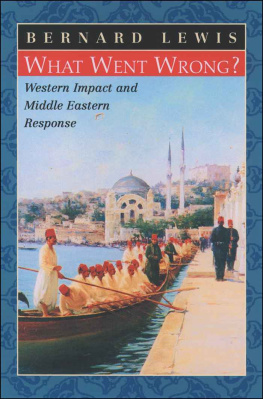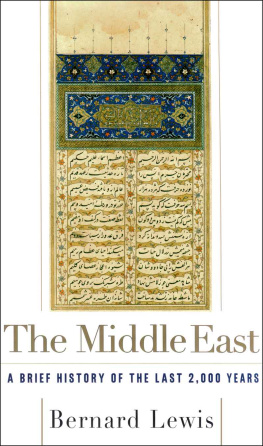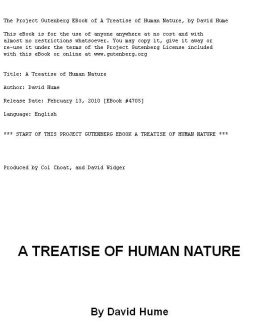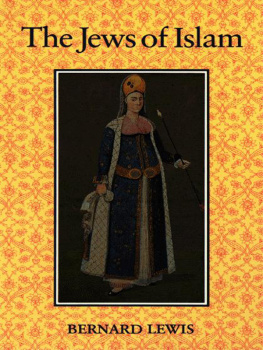Bernard Lewis - The Assassins: A Radical Sect in Islam
Here you can read online Bernard Lewis - The Assassins: A Radical Sect in Islam full text of the book (entire story) in english for free. Download pdf and epub, get meaning, cover and reviews about this ebook. year: 2008, genre: History. Description of the work, (preface) as well as reviews are available. Best literature library LitArk.com created for fans of good reading and offers a wide selection of genres:
Romance novel
Science fiction
Adventure
Detective
Science
History
Home and family
Prose
Art
Politics
Computer
Non-fiction
Religion
Business
Children
Humor
Choose a favorite category and find really read worthwhile books. Enjoy immersion in the world of imagination, feel the emotions of the characters or learn something new for yourself, make an fascinating discovery.
- Book:The Assassins: A Radical Sect in Islam
- Author:
- Genre:
- Year:2008
- Rating:3 / 5
- Favourites:Add to favourites
- Your mark:
- 60
- 1
- 2
- 3
- 4
- 5
The Assassins: A Radical Sect in Islam: summary, description and annotation
We offer to read an annotation, description, summary or preface (depends on what the author of the book "The Assassins: A Radical Sect in Islam" wrote himself). If you haven't found the necessary information about the book — write in the comments, we will try to find it.
The Assassins: A Radical Sect in Islam — read online for free the complete book (whole text) full work
Below is the text of the book, divided by pages. System saving the place of the last page read, allows you to conveniently read the book "The Assassins: A Radical Sect in Islam" online for free, without having to search again every time where you left off. Put a bookmark, and you can go to the page where you finished reading at any time.
Font size:
Interval:
Bookmark:

The Arabs in History
The Emergence of Modern Turkey
The Muslim Discovery of Europe
Semites and Anti-Semites
The Political Language of Islam
Race and Slavery in the Middle East
The Shaping of the Modern Middle East
Cultures in Conflict: Christians, Muslims and Jews in the Age of Discovery
The Middle East: 2000 Years of History from the Rise of Christianity to the Present Day
The Multiple Identities of the Middle East
A Middle East Mosaic: Fragments of Life, Letters and History
What Went Wrong: Western Impact and Middle Eastern Response
Bernard Lewis

To Michael
ix
x
i The title page of Lebey de Batilly's Traicre
2 The assassination of the Nizam al-Mulk
3 Authors, with scribe and attendants
4 Hulegu on his way to capture the Ismaili castles
5 Hiilegii
6 An inscription at the castle of Masyaf
7 The castle of Qa'in
8 The walls of Qa'in
9 The castle of Lamasar
to The rock of Alamut
i The castle of Maymundiz
12 Qal'a Bozi, near Isfahan
13 The castle of Masyaf
14 The citadel of Aleppo
My thanks are due to Professor J. A. Boyle and the Manchester University Press, for permission to cite a number of passages from Ata-Malik Juvaini, The history of the world-conqueror, translated from the Persian by John Andrew Boyle, Manchester 1958; to Professor K. M. Setton and the University of Winsconsin Press for permission to reproduce in this book some parts of my chapter on the Assassins in A history of the Crusades, editor-inchief Kenneth M. Setton, vol. i, The first hundred years, ed. Marshall W. Baldwin, Philadelphia 1955. I would also like to express my gratitude to Mr G. Meredith-Owens, of the British Museum, for his patient and invaluable help in finding and obtaining illustrations; to Dr Nurhan Atosoy, of the University of Istanbul, for her good offices in identifying and securing copies of material in Turkish collections; to Major Peter Willey, for generously placing his photographs at my disposal; to my wife and daughter for their help in correcting the proofs; and, finally, to Professor A. T. Hatto for once again letting me profit from his keen literary judgment and acute editorial eye. B.L.
The publishers acknowledge with thanks the permission of the following to include illustrations in this book: Major Peter Willey, plates 7, 8, 9, io and i i ; the British Museum, plates i and 5; Mr S. I. Asad, plates 6 and ig; the Suleymaniye Library, Istanbul, plate 3; the Director of the Warburg Institute, plate 4; and the Topkapi Sarayi Museum, Istanbul, plate 2.
Since this book first appeared in 1967 it has acquired a contemporary relevance which it did not have at the time of its original publication. This is perhaps indicated in its subsequent publication history. The English edition was reprinted several times both in Britain and in the United States. and a French translation in Paris appeared in 1982, with a long and interesting introduction by M. Maxime Rodinson. Three separate translations were published in Arabic, one of them with my prior knowledge and consent. An unauthorized Persian translation was published twice in Iran, first under the monarchy, then under the republic. Translations in Japanese, Spanish, Turkish, Italian, German, and Hebrew followed.
The changing nature of interest in the topic, and therefore in the book, is perhaps best indicated by the subtitles added by foreign translators and publishers. The English original was simply entitled The Assassins: A Radical Sect in Isluni. In the French translationthe first foreign-language edition--the subtitle was changed and became "Terrorism and Politics in Medieval Islam." The Italian translator retained my subtitle and added "The First Terrorists in History"-not, by the way, a correct statement. The German title was "The Assassins: On the Tradition of Religious Murder in Radical Islam."
The purpose of all these emendations was, clearly, to suggest a parallel between the movements and actions described in the book and those that are affecting much of the Middle East-and now also the Western world-at the present time. Certainly, the connection between the medieval Assassins and their modern counterparts are striking: the Syrian-Iranian connection; the calculated use of terror; the total dedication of the assassin emissary, to the point of selfimmolation, in the service of his cause and in the expectation of heavenly recompense. Some have seen a further resemblance in that both directed their attack against an external enemy, the Crusaders in one case, the Americans and the Israelis in the other.
There may indeed be such a resemblance, but if so, it is in the misapprehension rather than in the reality of these attacks. According to a view widespread in the Western world since medieval times, the anger and the weapons of the Assassins were directed primarily against the Crusaders. This is simply not true. In the long list of their victims, there were very few Crusaders, and even these were usually marked down as the result of some internal Muslim calculation. The vast majority of their victims were Muslims, and their attacks were directed not against the outsider, seen as basically irrelevant, but against the dominant elites and prevailing ideas in the Islamic world of their time. Some modern terrorist groups do indeed focus on Israelis and on Westerners. But others, probably in the long run more important, have as their targets the existing-in their view apostate-regimes of the Islamic world, and as their objective, the replacement of these regimes by a new order of their own. These points emerged very clearly from the statements made by the assassins of the Egyptian president Anwar Sadat. When the leader of the group proudly proclaimed: "I have killed pharaoh," he was clearly not condemning pharaoh for making peace with Israel but as the prototype-in the Qur'an as in the Bible of the impious tyrant.
There are also interesting resemblances and contrasts in their methods and procedures. For the medieval Assassins, the chosen victims were almost invariably the rulers and leaders of the existing order monarchs, generals, ministers, major religious functionaries. Unlike their modern equivalents, they attacked only the great and powerful, and never harmed ordinary people going about the avocations. Their weapon was almost always the same-the dagger, wielded by the appointed Assassin in person. It is significant that they made virtually no use of such safer weapons as were available to them at the time-the bow and crossbow, missiles, and poison. That is to say, they chose the most difficult and protected targets and the most dangerous mode of attack. The Assassin himself, having struck down his assigned victim, made no attempt to escape, nor was any attempt made to rescue him. On the contrary, to have survived a mission was seen as a disgrace.
Font size:
Interval:
Bookmark:
Similar books «The Assassins: A Radical Sect in Islam»
Look at similar books to The Assassins: A Radical Sect in Islam. We have selected literature similar in name and meaning in the hope of providing readers with more options to find new, interesting, not yet read works.
Discussion, reviews of the book The Assassins: A Radical Sect in Islam and just readers' own opinions. Leave your comments, write what you think about the work, its meaning or the main characters. Specify what exactly you liked and what you didn't like, and why you think so.












